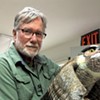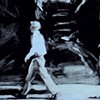Published July 3, 2002 at 4:00 a.m.
The directions to Ethan Hubbard’s house are complicated. Miss one of the turns and you can wander Orange County’s serpentine back roads for awhile without seeing any vehicles except tractors, and the dodgy cell-phone service makes it hard to call for remedial instructions. Along the way you pass homes both country-chic and, more typically, run-down rural, including a forlorn farm on a hairpin curve just downhill from Hubbard’s place. Once you finally arrive — where the narrow dirt lane stops on a forested hill above tiny Washington, Vermont — you realize the whole experience sort of mirrors Hubbard’s life.
Since 1968, when he first picked up a camera, Connecticut-born Hubbard has traveled to remote places in his adopted state of Vermont, around the U.S. and to nearly 50 other countries taking photographs of people. Especially old people “because they’re wise,” and children “because they’re fresh,” he says. Hubbard has shot 2600 rolls of film in those 34 years and, despite the breathtaking landscapes he’s seen, nearly all his frames are close-up portraits — always in black and white and with natural light. Hubbard has typically stayed in isolated outposts long enough to get to know his subjects before aiming his Canon.
The results of this personable approach are evident in eight books and in his current exhibit at Sterling College’s Brown Library in Craftsbury Common — the latest of some 50 solo shows he’s mounted over the years. For the most part, Hubbard’s subjects seem as comfortable with themselves as with the man behind the lens.
Hubbard, a lean and energetic 61-year-old, is photogenic himself, with probing blue eyes, graying locks and an impish smile. He says his interest in portraiture is two-fold: “Obviously I have a great love for people who are still connected to what I call ‘essence’ — to the earth, to agriculture, to sanity,” he explains. “And I believe, when I take the pictures, I’m clicking on some aspect of myself. I like to see the universality of people. I want to show what people look like — what people are like,” he adds, touching your arm gently for emphasis. “All of us have these expressions.”
What’s more, Hubbard says, “I believe the viewer feels the same way.”
“Ethan has a special feeling for people whether they’re in Vermont or Nepal or wherever,” says Tom Slayton, editor of Vermont Life, which published a photo-essay by Hubbard last summer. “He relates to them instinctively and naturally and they trust him, they just open their lives to him,” Slayton adds. “It’s absolutely stunning photography. He finds these wonderful people and takes very natural and direct shots.”
Slayton has hired Hubbard for freelance projects on occasion, including one that was Hubbard’s own idea: Chelsea couples. “It was people in Chelsea who had been married for a long, long time, just voicing their thoughts about each other,” he says. “It was sweet… It had such a great feeling.” The article “came out about the same time the civil union thing was cooking along,” Slayton notes. “If anything could say traditional marriage was alive and well in Vermont, that was it.”
Hubbard seems smitten by the elderly and their stories. He often says things like “I wanted to sit at his feet and soak him in” about characters like Harry Smith, a farmer who watched a ski resort build up around his land over a long lifetime in Waitsfield. Another old Harry is “one of the two top people in Vermont, in my opinion,” Hubbard says. “He should be president, he’s so wise.” That gentleman lives in his Cabot junkshop with 16 chihuahuas.
Hubbard is not the only local shooter, of course, to focus on old-timers in the Green Mountain State. Waterbury photographer Peter Miller published Vermont People in 1998; last year John M. Miller (no relation) of Coventry published Granite & Cedar. Both are beautiful black-and-white photography books that honor a fading way of life in rural Vermont. So will The Way Vermont Was, 1960-2000, Hubbard’s forthcoming collection of photo-essays.
Though he’s still bent on visiting all 251 Vermont towns, Hubbard’s wanderlust has not stopped at the state line. His passion for people in remote places has made him something of a one-man National Geographic.
If Ethan Hubbard is attracted to the vast human family, it may be because he was the black sheep of his own, growing up in Washington, Connecticut. Actually, he still is. His two brothers and sisters are “corporate” and uninterested in his life, Hubbard says resignedly. His father Walter — a “straight, Republican business guy” — was demeaning and impossible to please. “I was the all-wrong kid,” Hubbard recalls. “When I published my first book, I handed it to my father and he said, ‘It’s rather short, isn’t it?’”
Such slights surely provided fodder for plenty of therapy sessions. And Hubbard, who was named after his father, changed to Ethan a quarter-century ago. “I just wasn’t a Walter,” he says simply. Hubbard also seems to deflect negativity, a trait he might have inherited from his mother Kathryn. “She really believed in me and always encouraged me to follow my heart,” he says with obvious gratitude. In 1981, he took her on an adventure out West to “live with the cowboys and Indians — she loved it.” Both his parents are now deceased.
As a photographer, Hubbard was a late bloomer. After he’d graduated from Rollins College in Florida with a degree in creative writing, he headed to Vermont, a state he had fallen in love with during earlier family skiing trips. He worked for four years as an elementary school teacher, but “I wasn’t very good at it,” he confesses. He was married for three years in the late ’60s and had a son, whom he raised for a few years on his own. Taylor, now 35, is himself a schoolteacher and the father of Hubbard’s only grandchild, Ella.
Leaving the classroom behind in 1968, Hubbard switched gears to become deputy director of the Vermont Historical Society. For the next nine years, he took photographs around the state, collecting and presenting Vermontiana. “That’s where I found my voice, my love,” he says, still enchanted by the discovery. “Being at the feet of people with strong character, rural people who knew themselves, was so fascinating. I knew what I wanted to do with my life.”
Of course, it wasn’t all about visuals; Hubbard was a story collector and turned out to be a rhapsodic story teller. In 1977, he decided to leave the historical society and turn his lens on the wider world. He sold his house in Craftsbury — “I was able to go a long way on that,” he says. He self-published his first two photo-essay books, Vermont: Light Upon the Mountains in 1977 and Good Folks, Good Country two years later.
Hubbard lived simply, a near vagabond, setting up his tipi on land owned by friends. With a portable home base in Vermont, he began to travel farther and farther afield. That was made a lot easier in the 1980s and ’90s when some propitious investments in the stock market paid off: “I got lucky,” Hubbard says. “I’m not so lucky today. But even without the money, I would still be doing this.” The financial resources, he adds, allow him to send photographs back to his obliging subjects and “to help out a little bit along the way.”
Hubbard is keenly aware that, in most parts of the world, he is seen as a privileged white guy and, worse, a voyeur and opportunist. That’s why he goes out of his way to show respect to people, according to boyhood buddy Woody Hartman. A retired Ph.D. and former nature tour guide who lives in Maine, Hartman has known Hubbard since they were 13. Last spring, the two traveled together to Vietnam. Hartman recounts an incident in which Hubbard approached a homeless man and casually dropped a crumpled bill on the ground. “He set it up so the other person could think he found it, so it was not seen as charity. That’s the way his head works,” Hartman says.
While Hubbard was photographing the H’Mong mountain people in northern Vietnam, Hartman was usually off in the forest bird-watching, but sometimes he went along for the shoot. “The first thing that struck me was, he doesn’t have any formula for disarming people,” Hartman says of Hubbard’s style. “I always thought he had some technique, but he’s just like all the rest of us — he fumbles for what to say. But he’s fearless; he has no qualms about it at all.”
Hartman concedes he’s in awe of his friend’s ease with people. “It doesn’t matter if it’s someone on the street who catches his fancy or some old-timer on his porch, or in some primitive village, he just wades in.”
Melissa Fisher, Hubbard’s girlfriend of four years, agrees. “Ethan just has an eye for people. He’ll stop and talk to anybody just like that,” she marvels, “…and half an hour later you’re sitting down with them and having a meal or whatever, regardless of whether you speak the same language. People just seem to open up to him. It’s really quite amazing. After a week in a village he’ll have the entire place mapped out… He’ll know the names of 200 people.”
When Hubbard annotates his way through a stack of photos or an exhibit on the walls, he remembers every story, and his speech is peppered with superlatives — never a judgmental word. He seems almost reverential about his subjects and has been accused of romanticizing them. “I am a romantic in many, many ways,” Hubbard readily admits. Two labels he rejects: journalist and anthropologist. He seems to take his portraits at, well, face value.
About a gorgeous young Haitian mother dressed in rags, he says: “She had such disdain for 500 years of white enslavement. It’s one of my favorite pictures I’ve ever taken.” An old blind gospel guitarist with a mahogony face in Virginia: “His life was about singing the praises of the Lord.” A wizened Navajo medicine man in Arizona: “He would walk from village to village like a shaman.” Two old brothers in Middlesex, Vermont: “They’re very old-fashioned, they never leave home. The day their father died they got a generator and started watching videos.”
Hubbard once walked for three weeks in Nepal with a sherpa, who “would take us to these eccentric mountain people’s homes at night,” he says. One of them was a 7-by-12-foot hovel where an old man lived with his beloved cat. “Sleeping on a mat with him and my sherpa by the embers of a fire was the highlight of the trip,” Hubbard recalls. “I heard breathing and crickets; that was the Ritz-Carlton Hotel, to spend time with that man.”
One of his photographs of a Nicaraguan coffee worker is being put to activist use at the Hunger Mountain Co-op in Montpelier, Hubbard reveals. “Renaldo Hernandez has six kids. It’s dangerous, back-breaking work,” he says. “He makes 14 cents an hour. Renaldo Hernandez would have to work 18 hours to pay for one cappuccino in Vermont.” The photograph and text accompany a display promoting Equal Exchange coffee, whose mission is to pay third-world workers first-world rates for their beans.
“I’m not a crusader; I wish I were,” Hubbard says, “but I do a little bit here and there.
“Oh, you gotta do this one,” he exclaims, moving on to the photo of “Old Sog,” a portly gent in Utah. “I’ve had two out-of-body experiences: once during a birth and once with Old Sog,” Hubbard says. “He was crusty, smelly and couldn’t button his pants, but he was a genius. He knew how to grow things. I love my job so much that talking to him made me go to the ceiling.”
Whether capturing a fat old coot or a demure little black girl in braids, Hubbard’s photos are seductively intimate and intense, and yet they are deceptively ordinary, free of fancy techniques or digital enhancement. Most of them reinforce the adage that the eyes are the windows of the soul. “I look for clarity of the eyes,” he confirms. “The quality of the light is important, too.”
Hubbard’s writing has clarity as well; the prose is clean and straightforward, with a descriptive elegance that neither aggrandizes nor patronizes his subjects. Two of Hubbard’s books — First Light in 1986 and Journey to Ollantaytambo in 1990 — were issued by Chelsea Green Publish-ing. When that company’s niche evolved to sustainable-living texts, Hubbard’s photo books no longer fit, so he self-published two more books. In 1997, the companion volumes Face of a Woman and Face of a Man were published by Pilgrim Press.
A more recent project is a “perpetual calendar” called “The Spirit of Women” that features Hubbard’s photos and text. Produced by Raven Mark of Montpelier, the calendar is dedicated to the memory of his mother.
Hubbard has something in mind he’d like to pass on to another female in the family, his granddaughter Ella: “I want to do a book called Grandfather’s Gift,” he says. “It would take children around the world — a vehicle to visit people and tell them what’s still good about the world. It would be a little fanciful.”
Ethan Hubbard and Melissa Fisher both say Vermont is the best place to come home to. And certainly the particular place they call home is worth the trip — no matter how gnarly that road is in mud season. Built three years ago on the slope of a friend’s land, the two-story house is welcoming and uncomplicated; each floor is essentially one big room — even the bathroom upstairs has no walls. The downstairs is partially surrounded by glass and a wrap-around porch, and the view is stunning. Hubbard has artfully planted flowers and arranged rocks, and a retaining stone wall has been built against the hill.
Inside, evidence of foreign travel is abundant. Rugs from Morocco and Asia cover the floors; guide books to seemingly every country on the planet stand ready to be consulted. But this former tipi dweller isn’t big on possessions. Asked what he likes to bring back, Hubbard surmises, “fabric, little baskets, jewelry for Melissa, maybe a stone or a piece of wood.” Several statues of Buddha preside over the place, although, after years studying Zen and Tibetan Buddhism, Hubbard declares he is “no longer an ‘ist.’”
It’s surprising to learn that the darkroom in the basement is just a year old; for ages Hubbard has sent his film to Andrew Kline at Afterimage in Montpelier for processing and printing. Now he’s finally discovering the thrill of the image appearing before his very eyes. He’s having fun indoors for a change.
Not surprisingly, the walls of the house are lined with photographs, a constant reminder of where Hubbard has been and his inspiration to keep on wandering, looking and clicking. One picture, placed incongruously above the dishwasher, is particularly evocative. In it, a Japanese man perches, monk-like and cross-legged, on a ledge in the Himalayas, gazing outward as if yearning for — or perhaps trying to comprehend — the vast beyond.
Hubbard concedes that his trips are getting shorter — 10 days to two weeks rather than months. “I miss my home, Ver-mont, my partner, Montpelier, cappuccino,” he enumerates. “It’s always good to come home.” Practically in the same breath, though, he’s imagining another journey. “I really need to go to Cuba, and find the heart of the Cuban people,” he begins. “I want to find someone like Hemingway’s old man and the sea, to see his wife when he comes home…” His eyes light up at the thought.
More By This Author
Comments
Comments are closed.
From 2014-2020, Seven Days allowed readers to comment on all stories posted on our website. While we've appreciated the suggestions and insights, right now Seven Days is prioritizing our core mission — producing high-quality, responsible local journalism — over moderating online debates between readers.
To criticize, correct or praise our reporting, please send us a letter to the editor or send us a tip. We’ll check it out and report the results.
Online comments may return when we have better tech tools for managing them. Thanks for reading.















































